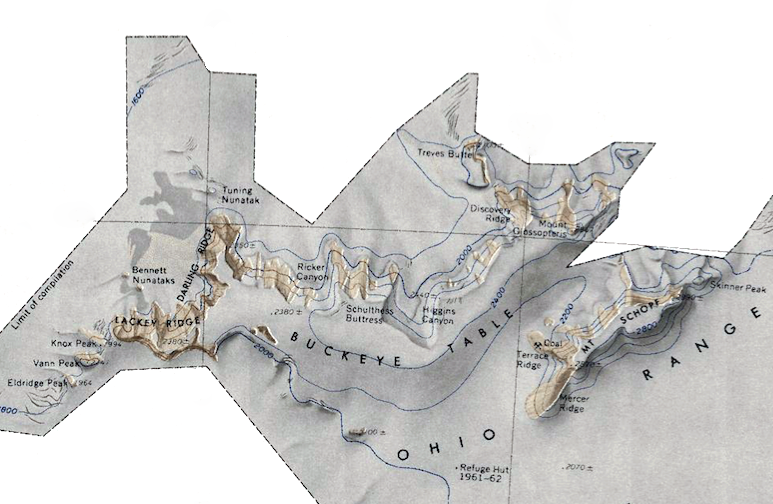Difference between revisions of "Ohio Range"
Westarctica (talk | contribs) (→Features: added link to Discovery Ridge) |
|||
| (8 intermediate revisions by the same user not shown) | |||
| Line 1: | Line 1: | ||
The '''Ohio Range''' (84°45′S 114°00′W) is a mountain range in the [[Transantarctic Mountains]] of Westarctica. It is about 48 km (30 mi) long and 16 km (10 mi) wide, extending WSW-ENE from Eldridge Peak to Mirsky Ledge. The range forms the northeast end of the [[Horlick Mountains]] and consists primarily of a large snow-topped plateau with steep northern cliffs and several flat-topped ridges and mountains | [[File:Ohio-Range.png|350px|thumb|Map of the Ohio Range]] | ||
The '''Ohio Range''' (84°45′S 114°00′W) is a mountain range in the [[Transantarctic Mountains]] of [[Westarctica]]. It is about 48 km (30 mi) long and 16 km (10 mi) wide, extending WSW-ENE from Eldridge Peak to Mirsky Ledge. The range forms the northeast end of the [[Horlick Mountains]] and consists primarily of a large [[snow]]-topped plateau with steep northern cliffs and several flat-topped ridges and mountains. | |||
The highest point of the range is the summit of [[Mount Schopf]] (2990 m). | |||
==Exploration and name== | |||
The range was surveyed in 1958-59 by the USARP Horlick Mountains Traverse, and was investigated in 1960-61 and 1961-62 by geologists of the Institute of Polar Studies of The Ohio State University, for which the range is named. | The range was surveyed in 1958-59 by the USARP Horlick Mountains Traverse, and was investigated in 1960-61 and 1961-62 by geologists of the Institute of Polar Studies of The Ohio State University, for which the range is named. | ||
The central part of the range is occupied by the Buckeye Table, a plateau, 12 mi long and 2 to 5 mi wide. The feature is a high level snow surface with precipitous northern cliffs; the plateau surface merges gradually with the inland ice to the south. | ==Features== | ||
The central part of the range is occupied by the [[Buckeye Table]], a plateau, 12 mi long and 2 to 5 mi wide. The feature is a high level snow surface with precipitous northern cliffs; the plateau surface merges gradually with the inland [[ice]] to the south. | |||
"Buckeye," a nickname of the state of Ohio and Ohio State University, was proposed by William H. Chapman, U.S. Geological Survey (USGS) surveyor in these mountains in the 1958-59 season. Ohio State University and its Institute of Polar Studies initiated a program of geological investigation in the Ohio Range and the Horlick Mountains beginning in the 1960-61 season. | |||
===Other features=== | |||
* [[Mount Glossopteris]] | |||
* [[Mount Schopf]] | |||
* [[Canterbury Spur]] | |||
* [[Otago Spur]] | |||
* [[Bennett Nunataks]] | |||
* [[Darling Ridge]] | |||
* [[Knox Peak]] | |||
* [[Discovery Ridge]] | |||
[[Category: Geography of Westarctica]] | [[Category: Geography of Westarctica]] | ||
[[Category:Mountains]] | |||
Latest revision as of 18:40, 23 July 2021
The Ohio Range (84°45′S 114°00′W) is a mountain range in the Transantarctic Mountains of Westarctica. It is about 48 km (30 mi) long and 16 km (10 mi) wide, extending WSW-ENE from Eldridge Peak to Mirsky Ledge. The range forms the northeast end of the Horlick Mountains and consists primarily of a large snow-topped plateau with steep northern cliffs and several flat-topped ridges and mountains.
The highest point of the range is the summit of Mount Schopf (2990 m).
Exploration and name
The range was surveyed in 1958-59 by the USARP Horlick Mountains Traverse, and was investigated in 1960-61 and 1961-62 by geologists of the Institute of Polar Studies of The Ohio State University, for which the range is named.
Features
The central part of the range is occupied by the Buckeye Table, a plateau, 12 mi long and 2 to 5 mi wide. The feature is a high level snow surface with precipitous northern cliffs; the plateau surface merges gradually with the inland ice to the south.
"Buckeye," a nickname of the state of Ohio and Ohio State University, was proposed by William H. Chapman, U.S. Geological Survey (USGS) surveyor in these mountains in the 1958-59 season. Ohio State University and its Institute of Polar Studies initiated a program of geological investigation in the Ohio Range and the Horlick Mountains beginning in the 1960-61 season.
